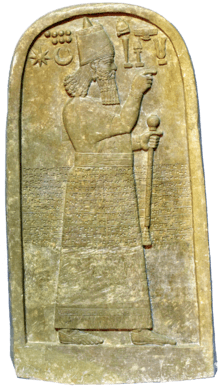Arik-den-ili
Arik-den-ili, inscribed mGÍD-DI-DINGIR, “long-lasting is the judgment of god,”[1] (1319–1308 BC or 1307–1296 BC) (short chronology) was an Assyrian king of the Middle Assyrian Empire (1366–1050 BC) who succeeded Enlil-nirari, his father, and was to rule for twelve years and inaugurate the tradition of annual military campaigns against Assyria’s neighbors.
| Arik-den-ili | |
|---|---|
| King of Assyria | |
| King of the Middle Assyrian Empire | |
| Reign | 1307–1296 BC |
| Predecessor | Enlil-nirari |
| Successor | Adad-nirari I |
| Issue | Adad-nirari I |
| Father | Enlil-nirari |
Biography
The sources are slim for his reign, less than ten inscriptions, a fragmentary chronicle and references to his affairs in those of his son[i 1] or perhaps brother,[i 2][i 3] Adad-nirari I’s accounts. He seems to have been the first of the Assyrian kings to have institutionalized the conduct of annual military campaigns,[2] some of which appear to be little more than livestock-rustling expeditions, as the chronicle mentions “a hundred head of sheep and goats and a hundred head of their cattle [...] he brought to Aššur.”[3]
Arik-den-ili’s first victories were against his eastern neighbours (the Pre-Iranic inhabitants of what was to become Persia), Turukku and Nigimhi, and all the chiefs of the (Zagros) mountains and highlands in the broad tracts of the Gutians to subdue the nomadic tribes on Assyria's northern and eastern frontiers. The Gutians had been vassals of the Kassites who ruled in Babylon and may have acted as their agents.[4] Nigimhi’s ruler was Esini. The Assyrians had invaded and carried off their harvest and in retaliation Esini led a force into Assyria which resulted in a massacre of his forces. Arik-den-ili besieged the town of Arnuna, in which Esini was holed up. Destruction of the gate and walls forced Esini’s capitulation and so he swore allegiance to his Assyrian overlord.[5]
The chronicle then lists Habaruha, Kutila, Tarbiṣu, Kudina, Remaku and Nagabbilhi. Of these only Tarbiṣu is known, a town a short distance from Nineveh. The residents of Halahhu seem to have borne the brunt of his wrath as he claimed to have killed 254,000 of them,[3] a fairly preposterous boast even for the period. He then turned westward into The Levant (modern Syria and Lebanon), where he subjugated the Suteans, the Aḫlamû and the Yauru, the nomadic West Semitic tribesmen who would become the Arameans, in the region of Katmuḫi in the middle Euphrates.[5]
But his activities were not limited to warfare. The temple of Šamaš at Aššur, as a mud-brick construction, had decayed into a mound of dirt surrounded by ad hoc shrines. “In order that the harvest of my land might prosper,” he had them cleared and rebuilt the temple, laying its foundation during the eponym year of Berutu, a son of the earlier king Eriba-Adad I. His own son credited him with the construction of the great Ziggurat of Aššur in one of his own building dedications.[5]
Like his father, Enlil-nirari, before him he had to battle inconclusively against Babylonia, in this case against king Nazi-Maruttaš. His son was to recall “my father could not rectify the calamities inflicted by the army of the king of the Kassite land” in a contemporary Assyrian epic.[4] That dispute was finally resolved with his son, Adad-nirari I's victory over the Babylonians.
Inscriptions
- Nassouhi list, iii 22–23: mdAdad-nārārī mār Arik2-˹de-en˺-[ili].
- Khorsabad list, iii 16–24: mdAdad-nārārī aḫu-šú ša mArik2-dīn2-ili.
- SDAS list, iii 17–18: mdAdad-nārārī aḫu-šú ša mArik2-dīn2-ili.
References
- K. Fabritius (1998). K. Radner (ed.). The Prosopography of the Neo-Assyrian Empire, Volume 1, Part I: A. The Neo-Assyrian Text Corpus Project. pp. 131–132.
- A. Leo Oppenheim (1964). Ancient Mesopotamia: portrait of a dead civilization. University of Chicago Press.
- Jean-Jacques Glassner (2004). Mesopotamian Chronicles. Brill. p. 185.
- I. E. S. Edwards, ed. (1975). Cambridge Ancient History, Volume 2, Part 2, History of the Middle East and the Aegean Region, c. 1380-1000 BC. Cambridge University Press. pp. 32, 275.
- A. K. Grayson (1972). Assyrian Royal Inscriptions, Volume 1. Otto Harrassowitz. pp. 54–57, 58, 67.
| Preceded by Enlil-nirari |
King of Assyria 1319–1308 BCE |
Succeeded by Adad-nirari I |
